
USHIO INC. and Consolidated Subsidiaries
Year ended March 31, 2017
The USHIO Group―comprising the parent company, 55 consolidated subsidiaries and 1 equity-method affiliate―engages mainly in manufacturing and marketing light sources, equipment, and machinery for industrial uses. The Group also engages in research and development and provides other services related to its businesses.
In the fiscal year ended March 31, 2017, the global economy continued to face an uncertain outlook, based on the possibility of changes in the economic policy direction of the U.S., following the inception of the new administration, although the U.S. economy remained on a gradual recovery footing. Another factor contributing to the uncertainty was the continued economic slowdown in China and developing markets. The Japanese economy followed a gradual recovery path, as corporate earnings, employment conditions and personal spending all showed signs of improvement.
In the cinema-related markets, which are key markets for the USHIO Group's imaging equipment and light sources, the number of screens continues to increase in developing markets, including China.
In the electronics market, a key market for the USHIO Group's optical equipment and light sources, demand increased for electronic components and small and medium-sized LCD panels for high-end smartphones.
Under these economic conditions, the USHIO Group took steps to bolster Group-wide synergies, including expanding visual imaging business solutions. In addition, the Group actively executed R&D investments in new technologies and products for the future, in fields such as the science and biomedical businesses.
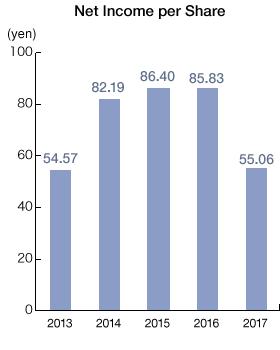
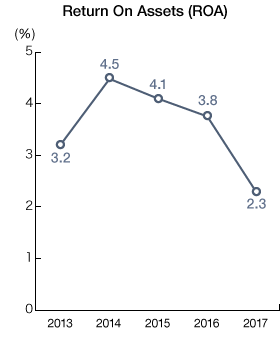
During the fiscal year ended March 31, 2017, both sales and income decreased.
Consolidated net sales decreased 3.5% year on year to \172,840 million. In the light sources business, sales decreased due to the foreign exchange impact of the yen’s appreciation against the dollar. In the equipment business, in addition to the foreign exchange impact, sales decreased mainly due to environmental changes and intensified competition in the imaging equipment market.
Operating income decreased by 34.5% year on year to ¥8,602 million. The USHIO Group implemented structural reform in connection with deteriorating business performance in the imaging equipment sub-segment, but this did not fully cover worsening profitability at the gross profit level.
Ordinary income declined 24.8% year on year to ¥11,001 million. This decline reflected the foreign exchange impact, despite the recording of realized and unrealized gain on trading securities, net.
Net income attributable to owners of parent declined 36.6% to ¥7,042 million. This decrease was mainly due to the posting of extraordinary losses such as business structural reform expenses, which were offset partly by the recording of a gain on sales of investment securities.
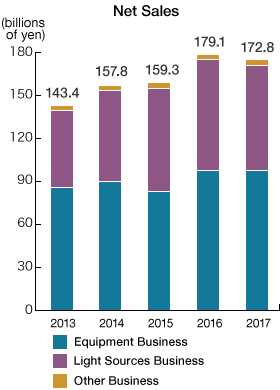
The equipment business saw sales decrease 1.0% year on year to ¥97,834 million, recording segment income of ¥74 million, down 95.7% year on year.
In the imaging equipment sub-segment of the business, in the cinema field, digital cinema projectors saw an increase in sales volume, but unit prices continued to decline for small and medium-sized models, for which demand has been increasing. In general imaging equipment, while the USHIO Group posted solid sales of imaging equipment for entertainment, primarily amusement parks and various events, but sales were sluggish primarily for small and medium-sized projectors for stationary imaging.
In the optical equipment sub-segment, sales were lackluster due to soft capital investment for lithography equipment for various electronic devices related to smartphones. However, sales increased for LCD panel manufacturing equipment, excimer cleaning unit for organic EL displays, and direct image exposure systems for main substrates of next-generation smartphones.
Sales in the light sources business decreased by 5.8% year on year to ¥74,046 million. Segment profit was down 26.0% year on year to ¥8,119 million.
In discharge lamps, UV lamps for lithography saw an increase in replacement demand as users’ operating rates remained high, in addition to an increase in capital investment by semiconductor-related manufacturers and OLED-related manufacturers. Meanwhile, in xenon lamps for digital cinema projectors, although demand increased due to the continuing installation of new cinema screens primarily in China, sales were impacted by intensified price competition. Sales of lamps for data projectors increased due to growth in new products by end-product manufacturers.
Demand for halogen lamps for office automation applications declined, due to economic weakness in developing countries.
Sales in other businesses increased by 2.8% year on year to ¥3,307 million and segment profit decreased by 77.0% year on year to ¥41 million. In other businesses, the USHIO Group posted higher sales of mold protection systems that monitor the injection-molding process, despite sluggish sales of packaging machinery, leading to the higher sales and lower segment profit.
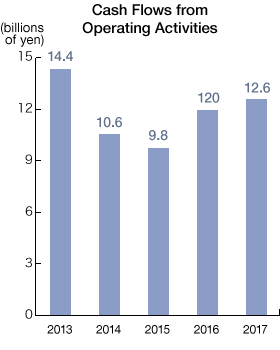
Cash and cash equivalents on March 31, 2017 totaled ¥50,974 million, up ¥3,161 million from the previous fiscal year-end. Cash flows are broken down as follows:
Operating activities in the fiscal year ended March 31, 2017 provided net cash of ¥12,624 million (compared with net cash of ¥12,031 million provided in the previous year). The main positive contributions to this result were ¥11,617 million in profit before income taxes, a ¥6,587 million adjustment for depreciation, and a \2,733 million decrease in inventories. Meanwhile, factors reducing cash included a \2,761 million gain on sales of investment securities, a \3,850 million increase in notes and accounts receivable – trade, and income taxes paid of ¥2,455 million.
Investing activities used net cash of ¥15,254 million (compared with net cash used of ¥10,367 million in the previous fiscal year). The main factors increasing cash were proceeds from withdrawal of time deposits of ¥10,493 million, proceeds from sales and redemption of securities of ¥5,992 million and proceeds from sales and redemption of investment securities of ¥6,164 million. The main factors decreasing cash were payments into time deposits of ¥15,090 million, purchase of securities of ¥3,197 million, purchase of property, plant and equipment of ¥8,828 million, and purchase of investment securities of ¥10,467 million.
Financing activities provided net cash of ¥6,864 million (compared with ¥7,849 million used in the previous fiscal year). The main factor increasing cash was proceeds from long-term loans payable of ¥15,601 million. Against this, factors decreasing cash included repayment of long-term loans payable of ¥3,376 million, purchase of treasury shares of ¥1,201 million, cash dividends paid totaling ¥3,347 million and payments from purchases of shares in subsidiaries not resulting in a change in scope of consolidation of ¥1,591 million.
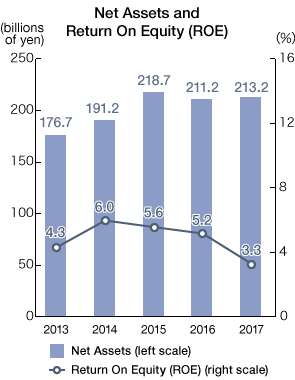
At the fiscal year-end, assets totaled ¥308,430 million, an increase of ¥13,905 million from the previous fiscal year-end. The main factors behind this increase were increases in cash and deposits in line with an increase in bank loans, and investment securities due to the purchase of bonds.
At the fiscal year-end, liabilities totaled ¥95,141 million, an increase of ¥11,912 million from the previous fiscal year-end. The main factors behind this increase were increases in short-term loans payable to meet demand for working capital and long-term loans payable.
At the fiscal year-end, net assets totaled ¥213,289 million, an increase of ¥1,993 million from the previous fiscal year-end. The main factor behind this increase was an increase in retained earnings due to the recording of profit. The main factor decreasing net assets was an increase in treasury shares, at cost due to the purchase of treasury shares.
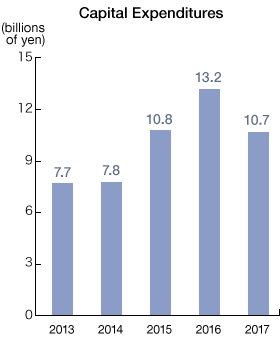
The USHIO Group's capital expenditures for the fiscal year ended March 31, 2017 were ¥10,740 million. The bulk of this expenditure was for capital investment in the light sources and equipment businesses, with investments focused on building up existing facilities, as well as on businesses promising growth in future, and research and development. A breakdown of capital expenditures for the fiscal year was as follows. (Figures are calculated on an acceptance basis for property, plant and equipment, intangible fixed assets, and long-term prepaid expenses. Amounts do not include consumption tax or other levies.)
| 2017 | YoY Change | |
|---|---|---|
| Light sources business | ¥4,971 million | 84.7% |
| Equipment business | ¥4,203 million | 61.2% |
| Other businesses | ¥1,565 million | 324.9% |
| Total capital expenditures | ¥10,740 million | 81.2% |
Capital expenditures decreased in the fiscal year ended March 31, 2017. This reflected the fact that in every segment the Group selected investments rigorously, focusing on capital efficiency.
The USHIO Group's investments focused mainly on the equipment and light sources businesses. In the equipment business, the Group focused its expenditure on optical equipment including lithography equipment and optical processing equipment targeting diversifying market needs, as well as laser projectors and sound systems in visual imaging fields, and simulation systems and virtual reality in general imaging fields. In the light sources business, the Group focused primarily on expenditure to maintain its high quality and technological advantages and to expand its solid state light sources (LEDs and laser diodes) business.
The Group funded its capital expenditures with a combination of internally generated funds and borrowings.
Loss on disposal of plant, property and equipment was ¥91 million, due to the disposal of plant facilities such as buildings and machinery in the light sources and equipment businesses.
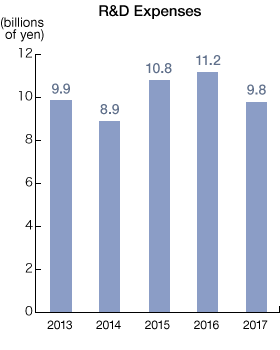
Group-wide R&D expenses totaled ¥9,812 million. Most of this was spent in the light sources and equipment businesses. The main targets of the Group's R&D were light sources for industrial applications for development and production, which included work use and application of optical applications in electronic and electromechanical equipment, moving ahead with development of indispensable peripheral technologies and development for commercialization of optical units, optical equipment and systemization. The Company stepped up its efforts to keep abreast of the latest developments in markets and technology and conducted strategic R&D activities. It is organized in a way that enables interaction among the R&D teams from different product groups to encourage development of new kinds of light sources and equipment. R&D expenses in every segment include inter-segment transactions.
The USHIO Group's key achievements during the fiscal year ended March 31, 2017 were as follows:
Our subsidiary USHIO OPTO SEMICONDUCTORS, INC. developed a red laser diode with a collimator lens. The product features a red laser diode with high output power, fitted with a collimator lens, which makes it easy for customers to use.
This red laser diode with high output power is intended for use as a solid state light source in cinema and industrial projectors. As such, this product offers prospects for future growth. This subsidiary is thus working to develop products with even higher output power. In blue-violet laser diodes, the subsidiary is also pushing ahead with the development of products with even higher output power for use in direct imaging exposure systems.
R&D expenses for the light sources business totaled ¥4,443 million.
Our subsidiary ADTEC Engineering Co., Ltd. developed a roll to roll direct imaging exposure system for the flexible printed circuit board industry. The new system has superior correction functions and does not require photo masks compared with conventional contact-type roll to roll exposure systems. Given that the original direct imaging exposure system that serves as the basis for the new system is dedicated to single-wafer processing, this subsidiary developed new processing methods such as feed and mount methods. As a result, the subsidiary successfully completed the development of a new roll to roll direct imaging exposure system with a 15 μm resolution.
Our subsidiary CHRISTIE DIGITAL SYSTEMS CANADA INC. developed high-brightness, high-image quality next-generation projection systems using RGB lasers for the cinema market. These next-generation projection systems are expected to steadily penetrate the market going forward. This subsidiary has simplified and reduced the size of the projector structure by using a high-output red laser device (MDP) and direct green lasers, which have been adopted for the first time for use in a projection system, thereby achieving significantly lower manufacturing costs. Moreover, taking full advantage of RGB laser beam characteristics, the new projection systems realize a maximum contrast ratio of 5000:1, which is higher than conventional lamp-based projectors. The development of next-generation projectors is expected to revolutionize the cinema industry.
The subsidiary will work to develop various derivative models based on optical systems designed for this newly developed projection system, targeting the general projection systems market outside the cinema market.
R&D expenses for the equipment business totaled ¥5,320 million.
The USHIO Group has been facing slowing growth in its existing markets. Accordingly, the Group believes that its key business priorities are to accelerate entry into new markets and the creation of new businesses, in conjunction with maintaining high shares and profitability in existing markets. In addition, in the light sources business, there has been gradual progress on the adoption of solid state light sources that will replace conventional lamps. With this in mind, the Group will steadily advance the solid-state light source business as another crucial business priority.
To implement these priorities, the Group will enhance its product lineup to respond to diversifying market needs, reduce manufacturing costs throughout its operations, and improve quality and productivity. In addition, the Group will endeavor to expand and reinforce its manufacturing bases as well as its sales bases and networks both in Japan and overseas. In doing so, it aims to optimize its service structure. At the same time, the Group will take steps to develop a proposal-oriented total-solution type business leveraging the strengths of existing technologies and products, as well as measures to harness open innovation, in order to expand its sales of high value-added light sources, optical equipment, and imaging equipment not only in existing markets but also in new markets around the world. Backed by its solid financial base, the Group will also seek to develop dynamic businesses by proactively undertaking synergy-driven M&As, business partnerships and related actions.
Moreover, the Group’s financial priority is to steadily achieve the balanced allocation of capital in connection with investments in growth and shareholder returns, while maintaining sound financial health.
The USHIO Group regards environmental issues as a key management concern in terms of corporate social responsibility, and will continue to take active steps to save energy and resources, cut waste, increase recycling, and otherwise reduce its environmental footprint.
Meanwhile, the Group will continue with measures to ensure that it merits the trust of all its stakeholders. These will involve optimizing its internal control systems by bolstering corporate governance and compliance, and ensuring continued stability in its operations by putting in place the best possible provision for risk management including business continuity planning.
Below is a summary of risks that could affect the USHIO Group's business performance, financial position, and cash flow adversely and materially.
These are the risks determined by the Group as of June 29, 2017. This is only a partial listing, and the Group faces risks other than those cited here that could also affect its business performance, financial position, and cash flow materially.
The Group’s business performance is affected by fluctuations in demand in the semiconductor and LCD industries. Currently, the USHIO Group’s product line includes lamps for manufacturing equipment. These products are consumables, and demand for these lamps is generally steady as long as customer plants are operating. However, the semiconductor and LCD manufacturing equipment the Group handles is affected by changes in demand for products in the short-term and the medium-to-long-term, as well as by technological developments, which can materially affect the Group’s business performance and financial position.
In addition to the semiconductor and LCD panel fields, the Group supplies light sources that are included in data projectors and digital cinema projectors and for illumination. Trends in technology and fluctuations in prices and demand for these light sources could materially affect the Group’s business performance and financial position.
The Group supplies cinema projectors and large projectors for business use. Fluctuations in demand in business areas, technical trends in the market, and fluctuations in prices could have a material impact on the Group’s business performance and financial position.
The Group relies on externally sourced raw materials that it obtains from a broad range of suppliers to ensure the steady supply of high-quality materials at stable prices. In particular, rare metals such as tungsten and molybdenum and specialty gas are the essential raw materials for manufacturing lamps. Supply shortages or price increases of these materials may boost manufacturing costs and materially affect the Group’s business performance and financial position.
The Group conducts manufacturing and sales activities in regions outside Japan, such as other Asian nations, North America, and Europe. Entry into these overseas markets is accompanied by potential risks in each country, such as changes in various rules and regulations, instability in securing human resources, underdeveloped infrastructure, and social unrest. If realized, these risks could materially affect the Group’s business performance and financial position.
The Group operates in business sectors characterized by frequent technological advances. Protecting, maintaining, and managing patents, trademarks, and other intellectual property are key factors to remaining competitive and maintaining a market share in those business sectors. Litigation could arise if a third party were to infringe on the Group's intellectual property rights, or if the Group were to infringe on a third party's intellectual property rights. In addition, the patent authorities could refuse patent applications submitted by the Group. Events such as these which would significantly compromise the Group's protection of its intellectual property rights, could affect the Group's business performance and financial position materially.
The Group conducts its commercial and financial operations such as investments and loans in yen and in other currencies. Profits and losses in the Group's commercial and financial operations conducted in foreign currencies are subject to the influence of fluctuations in currency exchange rates. The Group uses forward exchange contracts to moderate currency exchange risk, but it cannot negate this risk completely. Fluctuations in the foreign exchange rates could therefore materially affect the Group's business performance and financial position.
The Group holds marketable securities as financial assets. Depending on stock market and other conditions, the fair value of these securities could decline. Therefore, the Group is exposed to the risk of fluctuations in the prices of marketable securities, which could affect the Group's business performance and financial position materially.
There are no important contracts to report.